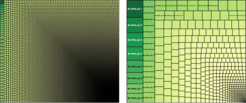Planarian Genomics
The regeneration of a planarian tailpiece necessitates the de novo activation of the various gene regulatory programs associated with head formation. The continuous differentiation of the pluripotent stem cell progeny into the various organismal cell types requires the sequential and orderly transition between gene regulatory states. And the diversity of regenerative abilities, body size or organismal life spans between planarian species must ultimately root in genomic sequences. All this makes planarian genomics a strategic nexus at the intersection between departmental research interests and the source of many intriguing questions.

Browser screen shot, highlighting putative regulatory regions of planarian SP-5 (top, green) on basis of chromatin accessibility (centre) and conserved non-coding elements in multi-genome comparisons (bottom).
Using PacBio long-read sequencing, we succeeded in generating a first high-quality assembly of the genome of the planarian model species S. mediterranea (Grohme et al., 2018). Moreover, we established and continue to develop PlanMine, the sequence database for the planarian research community (Rozanski et al., 2019, Brandl et al., 2016). And we use our long-read sequencing pipeline to continuously generate high-quality genome assemblies of other planarian species (unpublished). Our genome collection is beginning to reveal exciting glimpses of new classes of giant retroelements, the puzzling maintenance of heterozygosity even in sexually reproducing strains and indications of high rates of genomic drift, even within individual animals. Genome dynamics are intriguing in light of the abundant and active pluripotent stem cells, each of which is capable of re-building the entire animal and of contributing to the next generation. Moreover, genome comparisons between the more than 60 species that we maintain in the department promise exciting opportunities to link genotype to phenotype.
Questions we are interested in

TreeMap comparison between a highly fragmented previous assembly and our new high quality S. mediterranea genome assembly (right).
The unique biology of planarians, in conjunction with the genome tools that we are pioneering, provides access to many fascinating and fundamental questions:
- What are the gene regulatory networks that enable regeneration of the planarian body plan independent of the starting point?
- What are the genomic consequences of sexual versus asexual reproduction and why is asexual reproduction so common in planarians?
- What maintains individuality in the face of likely genetic drift amongst the somatic pluripotent stem cells, lack of a soma/germline divide and lack of clonality in regenerating fission fragments?
- What are the changes in regulatory elements between species that explain the wide range of regenerative abilities, life spans or body sizes in the planarians in our collection?

